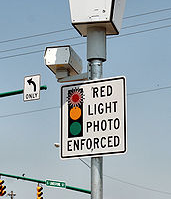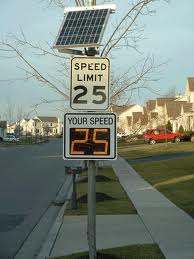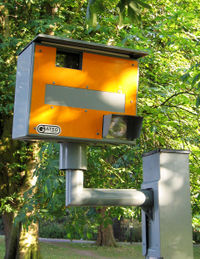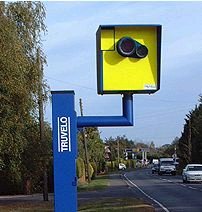(→Red Light Cameras: Added note on signs vs. cameras) |
(→Red Light Cameras: added sign photo) |
||
| Line 45: | Line 45: | ||
# They tend to be bulky<br />[[Image:Rlc_white.jpeg]] [[Image:Rlc_black.jpeg]]<br />[[Image:Rlc_gatso_rlc.jpeg]] [[Image:Rlc_gatso_US.png]] | # They tend to be bulky<br />[[Image:Rlc_white.jpeg]] [[Image:Rlc_black.jpeg]]<br />[[Image:Rlc_gatso_rlc.jpeg]] [[Image:Rlc_gatso_US.png]] | ||
# They have at least some equipment located behind the monitored intersection (there may be equipment on the other side of the intersection as well)<br />[[Image:Rlc_position.jpeg]] | # They have at least some equipment located behind the monitored intersection (there may be equipment on the other side of the intersection as well)<br />[[Image:Rlc_position.jpeg]] | ||
# They are clearly marked <br />[[Image:Rlc_sign1.jpeg]] [[Image:Rlc_sign2.jpeg]] [[Image:Rlc_sign3.jpeg]] | # They are clearly marked <br />[[Image:Rlc_sign1.jpeg]] [[Image:Rlc_sign2.jpeg]] [[Image:Rlc_sign3.jpeg]] [[Image:Rlc_sign4.png]] | ||
Revision as of 19:26, 22 August 2012
Waze supports numerous types of cameras and can provide client alerts when approaching a validated camera installation.
Know your Cameras
Also known as "What is NOT a Red Light Camera".
Before adding any cameras to the Waze map, you must be sure you are accurately reporting a camera installation. Many devices may have similar appearances, but very different functions.
The following devices all serve different purposes, but may all be installed at the same intersection.
Signal Preemption Systems
Traffic signal preemption is a type of system that allows the normal operation of traffic lights to be preempted, often to assist emergency vehicles. A very common system in the United States is the Opticom™ system by Global Traffic Technologies (GTT).
These devices have a few things in common:
- They are small and compact
- They are mounted facing the traffic they are monitoring
- They are typically mounted on the structures supporting the traffic signals
Traffic Cameras
Traffic cameras monitor the flow of traffic or the depth of a queue waiting for a signal. They allow for automated optimization of traffic signal timing, real time monitoring by police and highway departments, and public feeds to news outlets and the Internet.
These "cameras" may be video cameras, Radar transceivers, or a combination of the two. If Radar is used, it may trigger people's Radar Detectors and they may assume they are being monitored for speeding or other traffic violations although that is not the case unless additional camera equipment is also installed. Also note that some pedestrian cross walk equipment similarly uses Radar and may set off Radar Detectors.
Traffic cameras have a few main things in common:
- They are larger than Opticom type systems, but are still fairly compact
- They may point in any direction depending on what they are monitoring
NOTE: Traffic cameras may be installed along side of Red Light Cameras to provide additional views of suspected violations. Be sure to validate the existence or absence of Red Light Camera equipment as well.
Red Light Cameras
Red light cameras monitor an intersection and trigger when traffic proceeds through the intersection on a red signal. One or more approaches to the intersection may be monitored.
Red light cameras have a few main things in common:
- They have multiple lenses
- They have an external flash
- They tend to be bulky




- They have at least some equipment located behind the monitored intersection (there may be equipment on the other side of the intersection as well)

- They are clearly marked




NOTE: There may be signs warning of Red Light Cameras for directions NOT monitored by cameras. See the discussion on Camera Placement for details.
Driver Feedback Signs
Driver Feedback signs (a.k.a. radar speed sign, radar sign, Vehicle Activated Sign, Your Speed sign, traffic calming sign, etc.) can be either permanently installed or they may be mounted to a trailer which may be moved between locations.
NOTE: There may be a Driver Feedback Sign installed as part of a Speed Camera installation, but a Driver Feedback Sign alone is NOT a Speed Camera.
Speed Cameras (in general)
Speed Cameras are devices which monitor traffic for vehicles exceeding a set maximum instantaneous speed or for exceeding a maximum average speed over a fixed distance. Detection may be facilitated with Radar or wire loops embedded in the road surface.
They can be permanently installed or mounted temporarily. Temporary deployments include on trailers, hidden within vehicles, mounted to marked police vehicles, and handheld units.
Permanent installations often use similar equipment as Red Light Cameras, including the ubiquitous yellow/orange Gatso in the UK.
NOTE: Within Waze, the definition of a Speed Camera is limited to only permanent installations. See the Speed Cameras under Waze Camera Types section for details.
Waze Camera Types
Speed Cameras
These permanently mounted cameras monitor for instantaneous violations of maximum speeds. Systems that monitor average speed over a set distance (such as SPECS) are NOT supported at this time.
NOTE: Temporary or portable Speed Camera installations should NEVER be reported in the client or added to the map. It takes from a few days to many weeks for a new camera to show up in the client application on people's phones. Therefore a movable camera will be long gone before anyone ever gets an alert about it. These non-permanent situations should be reports as a Police hazard for this reason.
Red Light Cameras
Please make sure you only report true Red Light Camera installations and do not confuse other device types. See Know your Cameras above.
Dummy Cameras
It is common in the UK for authorities to install poles and enclosures for traffic enforcement camera which do not contain functional devices.
Camera Placement
Cameras should be placed over the roadway they are monitoring. The exact location depends on the type of camera:
- Speed Cameras should be placed at the location of the camera itself.
- Red Light Cameras should be placed at the stop bar they are monitoring.
Also be sure to place the correct quantity of cameras:
- If a Speed Camera monitors one direction of traffic, you need one camera.
- If a Speed Camera monitors both directions of traffic, you need TWO cameras.
- You need one Red Light Camera per monitored direction. So if you have a 4-way intersection with camera watching every direction, you need FOUR cameras. (See note below.)
NOTE: It is common to have signs warning of red light cameras at all approaches to the intersection although only a subset of those approaches may be monitored. For example, there may be signs on all 4 approaches to a 4-way intersection even if 3, 2, or even only 1 of the directions is actually monitored by a camera. Only the directions which are actually monitored by cameras should be added to the map.
Shutter Direction
When the camera icon is selected in the Map Editor, the red dot should point in the direction of travel a car will pass the camera. It does not matter if the real-life camera will take a picture of the front of the offending vehicle.
For example, if a road runs east-west and the east bound lanes are monitored for speed, the red dot should be on the eastern side of the camera icon in the Map Editor. Be sure the angle of the red dot also matches the angle of the flow of monitored traffic.
Adding Cameras
Cameras of all types can only be added to the map from the client application. You must be driving past the location of the camera installation (preferably on the correct road and in the correct direction) to issue this report.
Once you have submitted the camera report, it will appear on your client screen (and yours ONLY). Once that day's drives have been processed by the Waze servers, the camera will appear in the Map Editor where it can be approved. It must be approved for other drivers to be alerted of its presence.
Moving Cameras
If a reported camera is not in quite the right location, it can be moved within the Map Editor.
When you click on the camera icon, a circle appears; the camera can be moved anywhere within that circle. (After saving, you will be able to move the camera again within a re-centered circle.) Take care to ensure the red dot is facing in the proper direction after moving a camera.
Camera Speed
Speed Limit for a road which a Speed Camera is monitoring. Expressed in km/h worldwide, even if mph is used locally.
Camera Approval
All cameras must be approved in the Map Editor in order to appear in the client application. Once approved, the map tiles must be updated for this change to propagate out to the users.
Legality of Cameras
(Insert links to Country-specific pages here)







